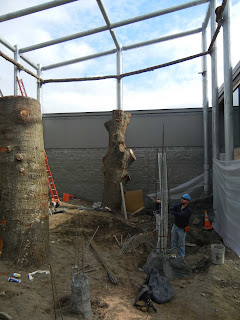Wow, what a crazy couple of weeks it's been clouded leopard-wise at the Zoo. Just as we are in the final, hectic throes of completing our long-awaited clouded leopard exhibit, we confirmed the pregnancy of its first resident! How's that for incentive to get the job done?!
For those of you who've never had the pleasure (?) of working under a tight deadline to create an animal exhibit that meets all the needs of your animals, visitors, and staff, I'll tell you it is a crazy mix of anxiety and ingenuity, stress and satisfaction. We began the process in November 2008 with
our design workshop and will hopefully get the darn thing finished within a couple of weeks. Getting us to the end of this long road was an incredible team of dedicated Point Defiance staff representing our Zoological, Operations, Education, Administrative, and Zoo Society teams. I am so fortunate to be working with truly some of the best folks in the business who despite the pressure of deadlines, glitches, and delays are always inspired by our conservation vision. You guys rock!
If you've missed my previous posts about the progression of the exhibit, you can review them
here and
here. But now I'd like to give you a update of our beautiful new Cats of the Canopy - one of the only clouded leopard exhibits in the country designed especially for the unique needs of these amazing, endangered cats.
This is how things looked just one week ago. Posts are in, but no work inside the exhibit. The pathway is being graded prior to pouring concrete:
What really makes this exhibit unique is the incredible height. Clouded leopards are most comfortable lounging way up in the canopy so we wanted to accomodate that need here. It's easy enough to set the support posts thirty-plus feet high, but the big challenge is adding the branching that will allow the cats to really utilize all that great space!
We had a crane for the day to set the logs in place:
First the big trunks were installed, then the limbs were hoisted up. It was pretty cool to see the terrific teamwork of biologists Paul and Andy working with operations guys Dennis and Joe. These limbs are wicked heavy, but these guys really knew what they were doing.
Joe and Dennis hooking up for the hoist:
Up it goes...
And up...
And up!
Then the logs had to be secured, forming a cat canopy walkway.
Thanks, Joe, for testing it out for the cats!
At the same time the climbing logs were going in, the Cemrock team was fabricating the cloudies' cave. This cave is designed to provide shelter and security for the cats, while still providing great viewing opportunities for visitors. This cave will have radiant heat in the ceiling, so the cats will stay cozy even on cold days.
Cemrock is also creating a large tree that will have a horizontal lounging branch running right past the window. The branch will also have a heating element to encourage them to hang out in great view.
These Cemrock guys are real artists, doing this work free form with guidance from some photos that describe the look we're going for - in this case a fallen rainforest tree.
On the other side of the exhibit is the visitor space where there will be opportunities to view videos of cubs, cats climbing (just in case they are resting when you visit), field research, wild video, and staff interacting with cats. The wood housing is for the monitor. The window will provide a peek into our "cub den" where we will house cubs that are being bottle raised.
The cub room is getting a great paint job by local artist Bob Henry:
Once the big logs were in and the crane was out of the way, mesh installation could commence:
At the same time, our horticulture team got going on plantings. Here lead horticulturist Bryon is saying goodbye to his beautiful palms as I describe what our young cloudies have in store for them (climbing, ripping, shredding, mauling...)
But right now they look beautiful!
So that brings us to the end of the day today. We still have lots to finish up over the next week or two including graphics installation, finish work behind-the-scenes, more landscape, etc. before the cats move in.
I hope you enjoyed the pictoral tour. It's pretty exciting to see it all coming together.
I'll keep you posted on the progress and give you a peek in back next time.























































